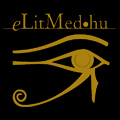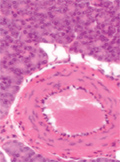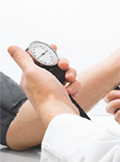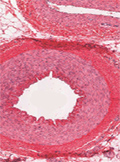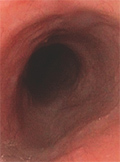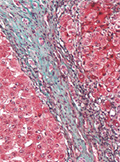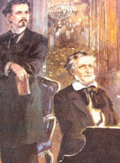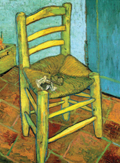The eLitMed.hu medical portal uses computer cookies for convenient operation. Detailed information can be found in the Cookie-policy.
Lege Artis Medicinae - 2014;24(08-09)
Content
[Parkinson’s disease from the perspective of general practice]
[Due to the recent developments in medicine, Parkinson’s disease became a relatively well-treatable condition. Recently the working abilities and the health-related quality of life of our patients dramatically improved by the application of optimal pharmacological and functional neurosurgical treatment options. Despite of these good progresses, the curative treatment option is still warranted. The aim of this review article is to present those pharmacological, neurosurgical and other treatments, which can improve the condition and quality of life of the patients. We also discuss the major concerns important for general practitioners including the assessment of driving abilities.]
[Rationality of incretin based therapy in type 1 diabetes]
[The incretin based therapy is applied at the early stage of type 2 diabetes mellitus. The mechanism of these drugs is partly independent from the functional β cells, therefore therapeutic effect can be expected at the late stage of type 2 diabetes mellitus, what is more in the case of type 1 diabetes. The type 1 diabetes mellitus can be used as a model to test these non-insulin secretion effects. In our work we summarize those clinical trials, in which incretin based therapy was used as a treatment of type 1 diabetic patients.]
[The advantages of the combination of amlodipine and atorvastatin and the experiences with the therapy]
[Hypertension and hyperlipidaemia are two major risk factors, as well as a single factor, but together are even more responsible for the cardiovascular death, which still isn’t reduced significantly in Hungary. About 2.5 million people suffer from hypertension in Hungary, and almost half of them do not reach the target level, and two-thirds of them have hyperlipidaemia as well. These risk factors are associated with other diseases. Obviously these illnesses can not be treated only with one drug. The European guidelines of the treatment of hypertension (ESH/ESC 2013) emphasise the importance of priorital of two-drug combinations, there is an evidence for the fix combinations of patients with major multiple risk factors in the beginning of the therapy. We used the combination of amlodipine/ atorvastatin in the treatment of hypertension during a three month period. The level of the blood pressure decreased of 18/11 mmHg, the cholesterin and the triglicerid values decreased 0.56 and 0.7 mmol/l. The patients got advices for the right lifestyle as well. In conclusion it can found, that the fix-drug combinations can improve the adherence, and they can help in the rigorous control of hypertension to prevent and treat the cardiovascular diseases.]
[Polyneuropathy as a first sign of microscopic polyangiitis]
[INTRODUCTION - Microscopic polyangiitis (MPA) is a systemic autoimmun disease characterized by necrotizing small vasculitis. MPA belongs to the ANCA-associated vasculitides. The disease can affect many of the body’s organ systems. Major organs involved are kidneys, skin, peripheral nerves and lungs. In addition, generalized symptoms such as fever and weight loss are very common. CASE REPORT - In January 2013 a 56-year old woman presented with weight loss, lower leg numbness, walking difficulty and petechiae on the lower legs. One month later, laboratory examinations showed progressive kidney dysfunction, anemia, hypersedimentation and elevated C reactive protein level, but further tests and investigations for potential bacterial infection and tumors were all negative. In sum, clinical signs and symptoms suggested systemic vasculitis, which was proved by the kidney biopsy and ENG examination. From these findings, microscopic polyangiitis was diagnosed with polyneuropathy and glomerulonephritis. The patient was a Hepatitis B (HBV) virus carrier, which can be provoking factor for vasculitis. Corticosteroid and six treatment cycles of intravenous pulse cyclophosphamide were performed for induction of remission. After treatment her symptoms improved and kidney function was normalized. Antiviral treatment was started because of HBV reactivation in October 2013. As a new manifestation of MPA, pulmonary symptoms were appeared in November 2013 and the patient was treated with synchronization of plasmapheresis and pulse cyclophosphamide with good clinical effectivity. Now, she is treated with methotrexate as immunosuppressive treatment and control examinations indicate the remission of the disease with proper renal function. CONCLUSION - We draw attention to a rare case of vasculitis and underline the importance of both the early diagnosis and the early and effective immunosuppressive therapy. Peripheral neuropathy may occur as a result of having systemic vasculitis. Nevertheless, the exploration and elimination of provoking factors are also must be part of the management and the regular follow-up is essential to recognize the disease relapses, thus avoid permanent organ damage.]
[Hungarian health care professionals’ attitudes and habits regarding blood donation in different professional groups]
[INTRODUCTION - We carried out a survey in Hungary among health care workers, we surveyed their habits in blood donation and their knowledge about the blood donation. METHODS - A cross-sectional study happened between 15th July and 15th Sep-tember in 2012 among the Adult nursing care-, Emergency care-, Surgical care-, and Maternity care professional groups, with convenience sampling statistical method (n=312). The data collection happened with a web-based, anonymous, self-administered questionnaire. For the edited electronic questionnaire we used some question from the “Eurobarometer 41.0 (1995): Europeans and the blood” survey. We analyzed the collected data with IBM SPSS Statistics 20 software and Kingsoft Office Spreadsheet (2012) program, using by descriptive statistical methods. RESULTS - The survey has occured with the participation of 312 health care workers. The blood donation activity of the health care workers in every professional groups was higher than the national average in a EU survey stated in 2009. 61.86% of the health care professionals give blood at least twice a year at different locations. The most common causes of the non-appearance from blood donation were the “other reasons”, “earlier forbidden from blood donation” and “lack of time”. We found differences in their view in each groups about refusing/authorizing blood transfusion, but these have no great importance. CONCLUSION - Regarding to our results we recommend to open the eyes to the need for common, aligned collaboration, and to the modifying the current competencies, to the betterment of the opportunities for further trainings in order to further increase of blood donation habits and attitudes. ]
[Health behaviour and cancer screening]
[The purpose of the paper is to find out: what influences the participation in cancer screening. For answer, concepts such as health, health consciousness, health culture, health behaviour have been taken into account, and the factors that have an influence on the health behaviour considered. It concludes that the participation in screening makes a part of the health behaviour which is a mandatory task for the health education to include screening into the health message. ]
1.
Clinical Neuroscience
[Headache registry in Szeged: Experiences regarding to migraine patients]2.
Clinical Neuroscience
[The new target population of stroke awareness campaign: Kindergarten students ]3.
Clinical Neuroscience
Is there any difference in mortality rates of atrial fibrillation detected before or after ischemic stroke?4.
Clinical Neuroscience
Factors influencing the level of stigma in Parkinson’s disease in western Turkey5.
Clinical Neuroscience
[The effects of demographic and clinical factors on the severity of poststroke aphasia]1.
2.
Clinical Oncology
[Pancreatic cancer: ESMO Clinical Practice Guideline for diagnosis, treatment and follow-up]3.
Clinical Oncology
[Pharmacovigilance landscape – Lessons from the past and opportunities for future]4.
5.
